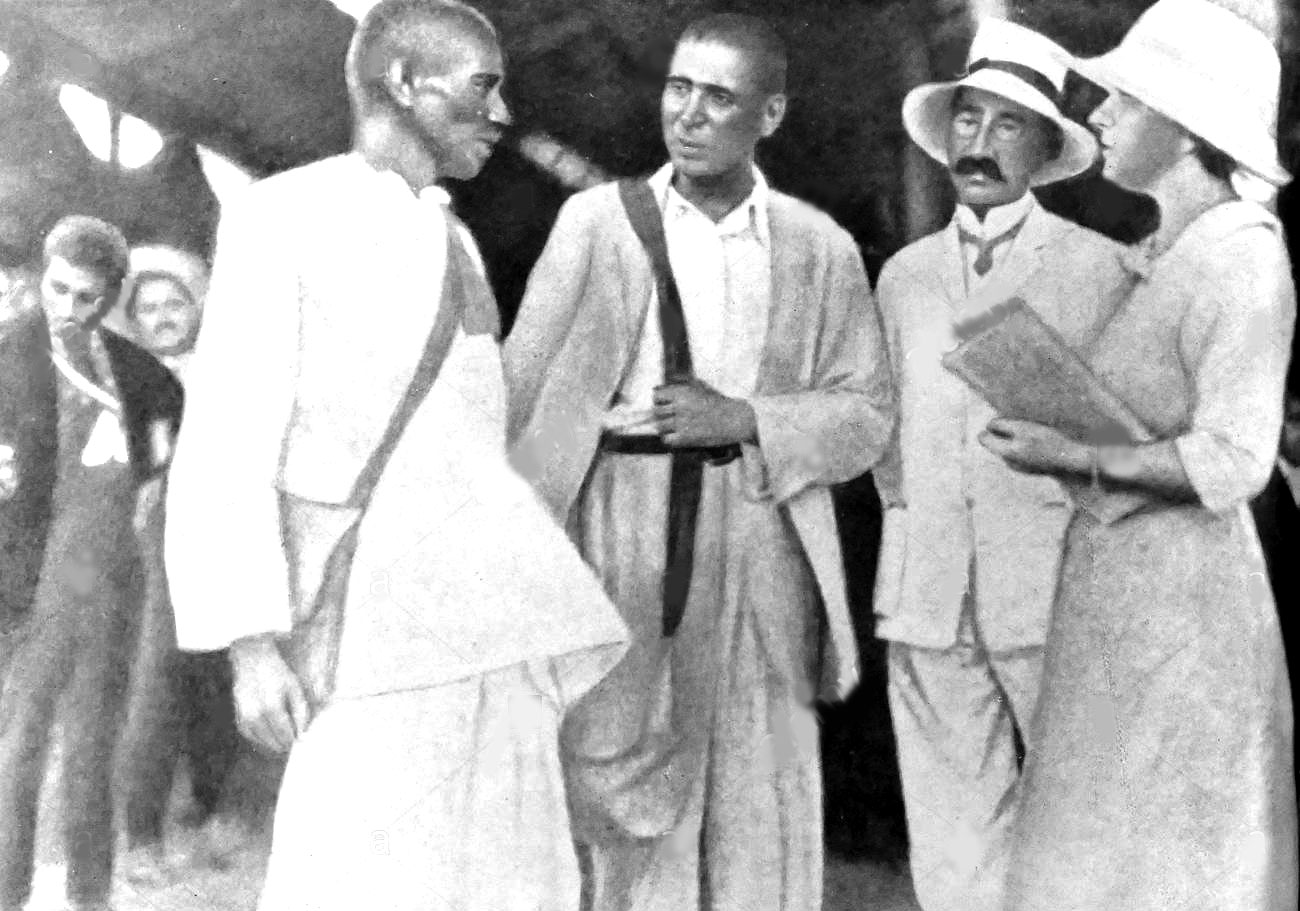Sanatan Articles
Satyaagrah
Written on
Satyaagrah
Written on
Satyaagrah
Written on
Satyaagrah
Written on
Satyaagrah
Written on
JOIN SATYAAGRAH SOCIAL MEDIA
Indian state bans book on Mahatama Gandhi after reviews hint at his gay relationship

Hermann Kallenbach (1871–1945) was a South African architect who was best known for his close association with Mahatma Gandhi (Gandhi’s name was Mohandas – Mahatma is an honorific title). Kallenbach was a German-Jewish bodybuilder who moved to South Africa in 1896. He met Gandhi (who was then working as a lawyer in South Africa) in 1904 in a vegetarian restaurant and soon thereafter became the love of his life. In fact, Gandhi left his wife for Kallenbach in 1908.
Two years later Kallenbach, a rich man, donated to Gandhi a thousand acre farm near Johannesburg. The property was used to run Gandhi's famous "Tolstoy Farm" that housed the families of satyagrahis (those who countered evil by non-violent means). Abandoning the life of a wealthy, sport-loving bachelor, Kallenbach adopted a simple lifestyle, vegetarian diet and the equality politics of Gandhi. In Gandhi’s autobiography he frequently referred to Kallenbach as his “soulmate,” a euphemism if ever there were one. Gandhi’s personal life was rife with hypocrisy.
 |
“He’s not the Messiah. He’s a very naughty boy!” -Brian’s mother in Terry Jones’ Life of Brian (1979)
A former executive editor of The New York Times and Pulitzer award winning author Joseph Lelyveld, has written a generally interesting book about Mohandas Gandhi, titled Great Soul; Mahatma Gandhi and His Struggle With India, which triggered a controversy at the time of its publication with Gandhi’s kin, and historians arguing that it was an attempt to sensationalize the life of the “father of the nation” and worldwide icon of non-violence.
|
The crux of the controversy seems to be the talks of two subjects on which Indians have strong views: Gandhi and sexuality (which society considers a matter so dirty that is not taught in schools). Some historians have note that key cultural differences between American and Indian attitudes to same-sex friendships might be the reason for which the American author suggests of a homosexual relationship. The author concludes that Gandhi was not only “a sexual weirdo“, and in more ways than one, but also “a political incompetent and a fanatical faddist.”
|
Gandhi wrote to Kallenbach about “how completely you have taken possession of my body. This is slavery with a vengeance.” Gandhi nicknamed himself “Upper House” and Kallenbach “Lower House,” and he made Lower House promise not to “look lustfully upon any woman” and the two pledged undying love to each other “as the world has not yet seen.”
 |
Kallenbach and Gandhi experimented with vegetarianism and spirituality. Kallenbach was a major person in Gandhi’s quest for non-violence. Gandhi and Kallenbach spend seven years alone in a home in Johannesburg.
The relationship was deep with long trails, and they shared a prevailing ideology. The letters between them show an erotic conversation. In one letter, Gandhi writes that when he sees Vaseline, it reminds him of Kallenbach. Gandhi says he has hung a photo of Kallenbach in his bedroom.
 |
Gandhi insisted that Kallenbach must dominate the relationship, and he is happy to be a slave.
 |
Gandhi required members of his ashram to be celibate, even married couples. Gandhi said: 'I cannot imagine a thing as ugly as the intercourse of men and women." He bragged that he was capable of “lying naked with naked women, however beautiful they may be, without being in any manner whatsoever sexually excited.” Gandhi also endeavored to bring his "feminine" side to the surface and extolled androgeny.
When Gandhi returned to India in 1915, Kallenbach was unable to get permission to travel to India, since England and Germany were at war. Even so, Gandhi never gave up hoping to get him back into his arms. Decades later Gandhi continued to write impassioned letters to Kallenbach, stating that “you are always before my mind’s eye.” Kallenbach reunited with Gandhi in 1936, when at last he was allowed to travel to India. He lived with Gandhi for weeks on end, and when Kallenbach became ill, Gandhi personally nursed him back to health.
 |
The book was banned in different parts of India like in the state of Gujarat which is Gandhi’s home state -the site of his ashram and the historic Salt March- and where has been ruled for the last decade by the Hindu nationalist BJP; which styles itself as the defender of traditional Indian values. However, it would be difficult to consider the near decade-long rule of chief minister Narendra Modi as an era of Gandhian virtue. But the author had the last laugh on this issue: Banning the book was a great favor to him because the publisher was able to triple the print run.
Was really Gandhiji bisexual? Many people really didn’t care when the issue came out, and felt that the media was making a mountain out of a molehill from this story, arguing that the sexual orientation of a person is his or her own business, so Gandhi, as he is known for his principles and what he has done for India, the majority thought that to comment on such matter is worthless because he would have written clearly about it in his auto-biography.
 |
Lelyveld has maintained that his book is “not sensationalist“, and is based on material already published by another writers and historians. He thought that his book might raise eyebrows because of the way it explores the conflict between Gandhi’s ideals and the country that venerates him. But when it was published, much of the reviewers and readers attention focused on just a few paragraphs in which he discusses Gandhi’s possible physical relationship with his Jewish friend. In all, it represents 10 to 12 pages in a book of about 350 pages, and the paragraphs that got attention were 3 to 4 paragraphs of those pages. The author claim that Gandhi was not a saint, but a man of great moral seriousness.
 |
According to Gandhi’s own wife, Gandhi engaged in heterosexual intercourse, but it repulsed him so much it actually made him physically ill, and he vowed never to attempt it again. The deification of Gandhi by the society throughout history intentionally eclipse Gandhi the real man. For example, in the 1930s, both Gandhi and Jawaharlal Nehru attempted to erase all traces of the Indian homoerotic tradition from Indian temples as a result of their systematic campaigns of “sexual cleansing“.
In the later stages of his life, Gandhi aspired to a kind of sexlessness; on his ashram, where even married inmates had to swear celibacy, he said: “I cannot imagine a thing as ugly as the intercourse of men and women.” He regularly slept with his 17-year-old great niece Manu and other women but tried to not to become sexually excited. He once told a woman: “Despite my best efforts, the organ remained aroused. It was an altogether strange and shameful experience“.
In the book of Lelyveld also details one instance in which he forced Manu to walk through a part of the jungle where sexual assaults had in the past taken place just to fetch a pumice stone for him he liked to use to clean his feet. She returned with tears in her eyes but Gandhi just “cackled” and said: “If some ruffian had carried you off and you had met your death courageously, my heart would have danced with joy“.
Gandhi’s sex life has been a controversial topic, even during his lifetime. The Chief Minister of Travancore, a princely state of India, described Gandhi as a sex maniac.
Rival independence leader, Mohammed Ali Jinnah, the founder of Pakistan, pointed out the same of Gandhi’s character, which tarnished his image among Muslims in British India. Gandhi’s experiments with young women were so well-known that close ally Jawaharlal Nehru refused to discuss his associate’s sex life.
Many historians noted Gandhi’s casual comments about young boys and girls. Gandhi insisted that he slept and bathed with young underage girls to check his perseverance to temptation.
The acts came to light due to the efforts of women who were part of Gandhi’s ashram. Gandhi had ordered in his ashram even the newlywed couple shouldn’t sleep together. Mysteriously Gandhi even asked mischievous boys and girls to bathe together.
 Support Us
Support Us
Satyagraha was born from the heart of our land, with an undying aim to unveil the true essence of Bharat. It seeks to illuminate the hidden tales of our valiant freedom fighters and the rich chronicles that haven't yet sung their complete melody in the mainstream.
While platforms like NDTV and 'The Wire' effortlessly garner funds under the banner of safeguarding democracy, we at Satyagraha walk a different path. Our strength and resonance come from you. In this journey to weave a stronger Bharat, every little contribution amplifies our voice. Let's come together, contribute as you can, and champion the true spirit of our nation.
 |  |  |
| ICICI Bank of Satyaagrah | Razorpay Bank of Satyaagrah | PayPal Bank of Satyaagrah - For International Payments |
If all above doesn't work, then try the LINK below:
Please share the article on other platforms
DISCLAIMER: The author is solely responsible for the views expressed in this article. The author carries the responsibility for citing and/or licensing of images utilized within the text. The website also frequently uses non-commercial images for representational purposes only in line with the article. We are not responsible for the authenticity of such images. If some images have a copyright issue, we request the person/entity to contact us at This email address is being protected from spambots. You need JavaScript enabled to view it. and we will take the necessary actions to resolve the issue.
Related Articles
- If not for Muslim appeasement, Vande Mataram would have been India's National Anthem: the history of Muslim opposition and support
- Anuj Dhar claims that Subhas Chandra Bose was suspected of being ‘poisoned’ after ouster from the post of Congress president
- An Artisan Heritage Crafts Village: Indigenous Sustainability of Raghurajpur
- On World Refugee Day, read how Germany, Sweden, and India bore the brunt of incoming refugees
- Giant hypocrite: Activist confronts Twitter CEO over censorship, asks why he ‘hates Jews and Conservatives’
- Soft-conditioning of Hindu minds to normalize grooming jihad in Bengali TV serial ‘Khorkuto’
- Is Maha Vikas Aghadi alliance in Maharashtra on the verge of an imminent collapse?
- Srinagar: Top LeT commander, 1 Pakistani terrorist killed in encounter, AK-47s recovered
- Jagannath Temple administration issues clarification on proposed sale of temple lands
- ‘Don’t use IMA to propagate any religion’: Read what the Delhi court said slamming IMA President John Rose Jayalal
- Government of India gives Twitter "one last notice" as "gesture of goodwill" to comply with IT Rules, 2021
- The stand-off with Twitter is not about politics, it’s about a ‘messiah syndrome’: Twitter Vs GOI over free speech and local law
- Communist rockstar KK Shailaja displays ugly Hinduphobia in Kerala assembly
- Viral video shows Agra hospital owner admitting he switched off oxygen of critical patients, probe ordered
- Supreme Court: Justice Indira Banerjee Recuses From Hearing Petition On Political Murders In West Bengal, Matter Adjourned With No New Date





















